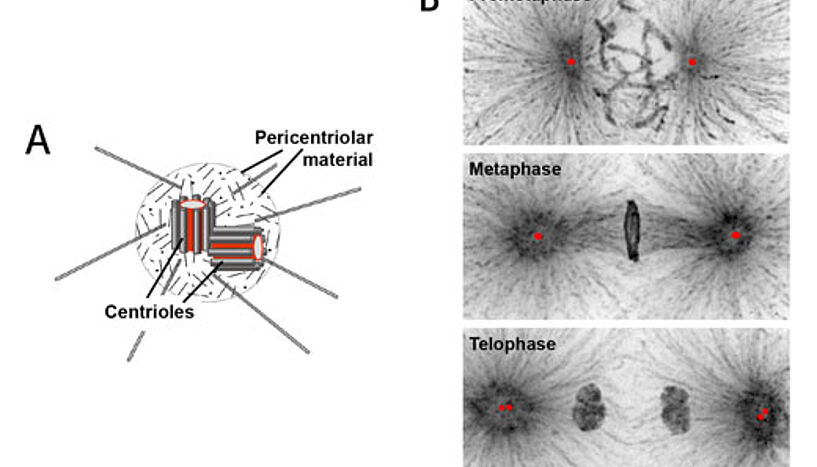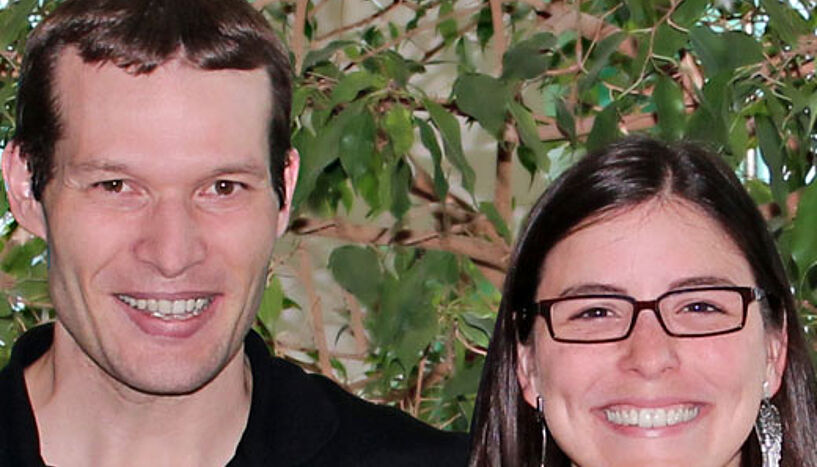Keeping centrioles in check to ensure proper cell division
22. Juli 2013The duplication of cellular contents and their distribution to two daughter cells during cell division are amongst the most fundamental features of all life on earth. How cell division occurs and is coordinated with organismal development is a subject of intense research interest, as is how this process malfunctions in the development of tumors. Alex Dammermann and his team from the Max F. Perutz Laboratories (MFPL) of the University of Vienna and the Medical University of Vienna, together with his collaborators from the Institute of Molecular Pathology (IMP), have been investigating how the duplication of one key component of the cell division machinery, named centrioles, is coordinated with the cell cycle – the series of events that lead to a cell’s division. Their results are published in the journal Current Biology today.
Centrioles – orchestrators of cell division
When our cells divide, their genetic material – in the form of X-shaped chromosomes – is aligned in the middle of the cell and segregated to opposite poles of the cell by a spindle of long tubular fibers, so-called microtubules. The structures that organize the two poles of the spindle in animal cells are called centrosomes. Each centrosome consists of two cylindrically shaped centrioles that are positioned perpendicular to each other and surrounded by an amorphous dense mass called the pericentriolar material (PCM). At the end of cell division, the two centrioles inherited by each daughter cell separate, and later each of them forms a new centriole. This ensures that another bipolar spindle can be set up by two centrosomes when the cell divides again. Precise control of centriole separation and duplication is therefore essential for successful cell division. Abnormal centrosome numbers are commonly observed in human cancers and are thought to be at least in part responsible for the improper distribution of the genetic material that is a hallmark of many cancer cells.
The PCM – the glue that keeps centrioles together
Until now, it was unclear how centrioles are held together and how their separation at the end of cell division is so precisely regulated. Gabriela Cabral, a PhD student in the lab of Alex Dammermann at the Center for Molecular Biology of the University of Vienna, explains: "Many people thought that centrioles are held together by the same glue as chromosomes, a substance called cohesin, which is destroyed during cell division. We found this to be true only in the very specialized circumstances surrounding fertilization. In all other cases, as in the subsequent cell divisions following fertilization, the glue that holds centrioles together is actually the PCM." These findings explain previously conflicting data on the mechanism of centriole separation. Alex Dammermann adds: "The surprising finding that there are actually two cellular mechanisms for controlling centriole separation was only possible because we use the nematode worm C. elegans as our model organism. Would we have used cell cultures we would have never found that centriole separation works differently in different developmental contexts".
Stem cell fate and cancer
The dense mass of the PCM that entraps the sister centrioles is itself disassembled at the end of cell division. The microtubules that are responsible for separating the genetic material also appear to be involved in pulling the PCM and centrioles apart. This tightly regulated process is critical to ensure that both daughter cells will later have the correct centrosome numbers when they divide. This is important to avoid missegregation of the genetic material, which may result in cell death or tumor formation. Interestingly, centrosomes have also been linked to the segregation of cell fate determinants. Gabriela Cabral explains: "When a stem cell divides, it doesn’t produce two identical daughter cells as normal cells do. It produces another stem cell and a daughter cell that may differentiate into one of many specialized cell types." What these cell fate determinants are and how they are distributed when a stem cell divides is another big question. However, it is known that centrosomes are also involved in this process. Alex Dammermann says: "Our results show that the PCM still harbors many surprises. One of our current research goals is to examine how this largely mysterious accumulation of cellular material is organized and we hope that a better knowledge of this will help us understand how centrosomes perform their manifold functions in the cell."
Original publication in Current Biology:
Gabriela Cabral, Sabina Sanegre Sans, Carrie R. Cowan, and Alexander Dammermann: Multiple mechanisms contribute to centriole separation in C. elegans. Current Biology (July 2013).
DOI: http://dx.doi.org/10.1016/j.cub.2013.06.043
Max F. Perutz Laboratories
The Max F. Perutz Laboratories (MFPL) are a center established by the University of Vienna and the Medical University of Vienna to provide an environment for excellent, internationally recognized research and education in the field of Molecular Biology. Currently, the MFPL host around 60 independent research groups, involving around 500 people from over 40 nations.
Scientific contact
Dr. Alex Dammermann
Max F. Perutz Laboratories
Department of Microbiology,
Immunobiology and Genetics
University of Vienna
1030 Vienna, Dr.-Bohr-Gasse 9
T +43-1-4277-546 81
alex.dammermann(at)univie.ac.at
Press contact
Dr. Lilly Sommer
Max F. Perutz Laboratories
Communications
T +43-1-4277-240 14
lilly.sommer(at)univie.ac.at
Wissenschaftlicher Kontakt
Assoz. Prof. Alexander Dammermann
Max Perutz Labs Department für Mikrobiologie, Immunbiologie und GenetikUniversität Wien
1030 - Wien, Dr.-Bohr-Gasse 9
+43-1-4277-546 81
alex.dammermann@univie.ac.at
Rückfragehinweis
Dr. Lilly Sommer
Max F. Perutz Laboratories, CommunicationsUniversität Wien
1030 - Wien, Dr.-Bohr-Gasse 9
+43-1-4277-240 14
lilly.sommer@univie.ac.at
Downloads:
Dammermann_Figure_02.jpg
Dateigröße: 566,03 KB
Dammermann_Cabral_02.jpg
Dateigröße: 503,86 KB


